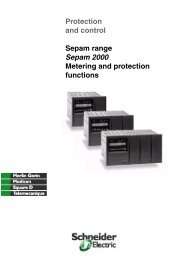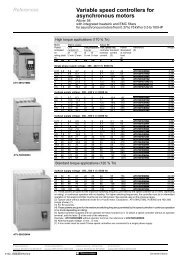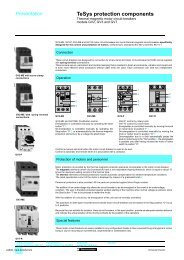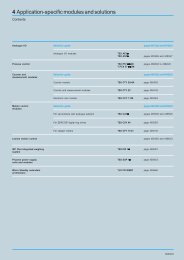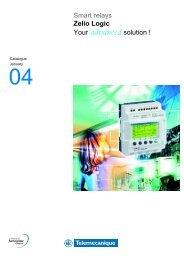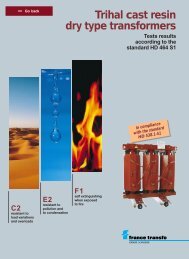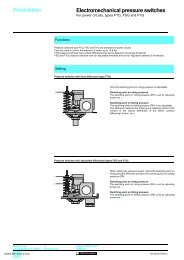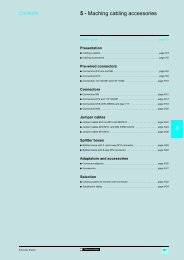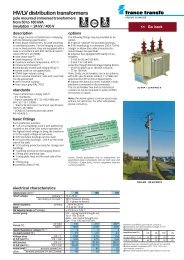Soft starters - Trinet
Soft starters - Trinet
Soft starters - Trinet
Create successful ePaper yourself
Turn your PDF publications into a flip-book with our unique Google optimized e-Paper software.
Functions (continued) <strong>Soft</strong> <strong>starters</strong> 0<br />
Altistart 48 soft start - soft stop units<br />
C<br />
(Cn) 100 %<br />
LUL + 10 %<br />
LUL<br />
t < tUL<br />
20 %<br />
Motor underload detection (ULL)<br />
tUL<br />
ULL<br />
t<br />
Protection functions (continued)<br />
# Motor underload protection<br />
The starter detects a motor underload if the motor torque falls below a preset torque<br />
threshold (LUL) for a specific (adjustable) period of time (tUL).<br />
The motor underload threshold can be set between 20% and 100% of the nominal<br />
motor torque. The permissible underload duration can be set between 1 and 60 s.<br />
The detection function can trigger an alarm or a fault. The detection function can be<br />
disabled. The "motor underload detected" alarm can be indicated by a configurable<br />
logic output and/or displayed via the serial link in the state of the starter.<br />
The "motor underload detected" fault (ULF) locks the starter and can be displayed<br />
via the serial link.<br />
I<br />
300 %<br />
# Excessive acceleration time protection<br />
This protection function can be used to detect a start which takes place in adverse<br />
conditions. Examples of such conditions include a locked rotor or a motor unable to<br />
reach its nominal rotation speed.<br />
If the start duration is greater than the value set (between 10 and 999 s),<br />
the drive changes to fault mode. The function can be disabled.<br />
LOC<br />
LOC -10 %<br />
50 %<br />
t < tOL<br />
Motor overcurrent detection (OIL)<br />
tOL<br />
OIL<br />
t<br />
# Current overload protection<br />
The starter detects a current overload if the motor current exceeds a preset<br />
overcurrent threshold (LOC) for a specific (adjustable) period of time (tOL).<br />
The overcurrent threshold can be set between 50% and 300% of the nominal motor<br />
current.<br />
The permissible overcurrent duration can be set between 0.1 and 60 s.<br />
This function is only active in steady state.<br />
The detection function can trigger an alarm or a fault. It can also be disabled.<br />
The "current overload detected" alarm can be indicated by a configurable logic output<br />
and/or displayed via the serial link.<br />
The "current overload detected" fault (OLC) locks the starter and can be displayed<br />
via the serial link in the state of the starter.<br />
# Protection against line phase inversion<br />
This function can be used to detect the direction of rotation of the motor phases and,<br />
if it is enabled, to indicate a fault when the direction of rotation is reversed.<br />
# Time before restarting<br />
This function can be used to avoid several consecutive starts which may cause:<br />
- the thermal overheating of the application, which is not permitted<br />
- a thermal fault which will require maintenance work to be carried out<br />
- overcurrents (if the direction of rotation is reversed) or repeats (run/stop<br />
commands)<br />
Following a stop command, the motor can only restart once the preset time delay has<br />
elapsed.<br />
The motor is restarted once the time delay has elapsed if a run command is still valid<br />
or if a new run command is sent.<br />
Adjustment range: 0 to 999 s.<br />
Configuring the starter overload and underload with<br />
PowerSuite on a PC<br />
# Motor phase loss detection<br />
The function is used to adjust the sensitivity of the protection function in order to<br />
detect a loss of current or a low current in one of the three motor phases for at least<br />
0.5 s or in all three motor phases for at least 0.2 s. The value of the minimum current<br />
level can be set between 5% and 10% of the starter nominal current.<br />
# Automatic restart<br />
After locking on a fault, the function permits up to six restart attempts at intervals of<br />
60 s if the fault has disappeared and the run commands are still present. After the<br />
sixth attempt, the starter will remain locked and the fault will have to be reset before<br />
a restart is permitted.<br />
If the function is active, the fault relay remains activated if line phase loss, motor<br />
phase loss or line frequency out of tolerance faults are detected. This function can<br />
only be used in 2-wire control.<br />
Schneider Electric<br />
60526_Ver1.10-EN.fm/5



